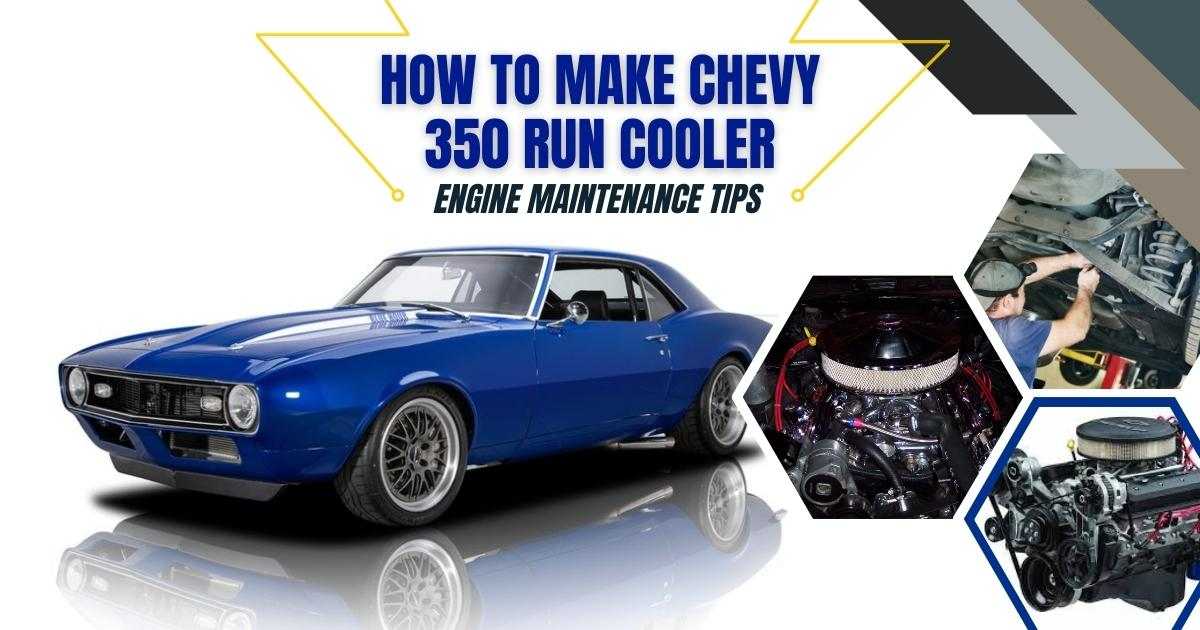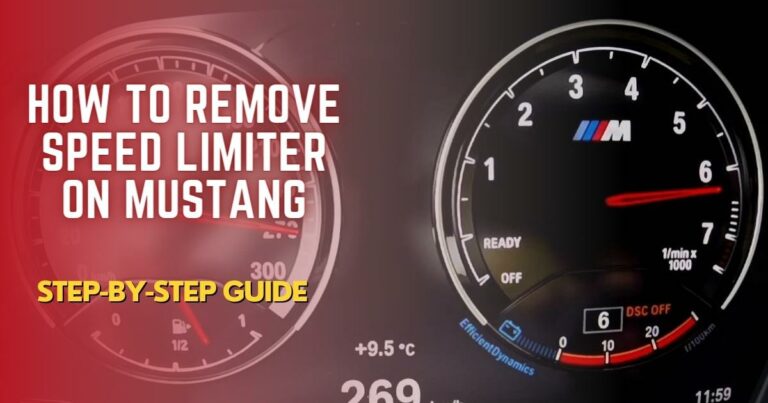How to Make Chevy 350 Run Cooler- Engine Maintenance Tips
The Chevrolet 350 engine, often referred to as the Chevy 350, is a legendary motor known for its performance and versatility. Renowned for its exceptional blend of durability, quiet operation, and performance, the 350 has cemented its place in automotive history as one of the best engines of its time.
However, the Chevy 350 engine can overheat when it encounters problems with its cooling system. Occasional overheating can lead to damage and reduced performance, so learning how to make engine run cooler is crucial for its longevity and efficiency.
In this guide, we’ll show you how to keep your Chevy 350 engine running cooler to enhance its performance and make it last longer.

What Causes a Chevy 350 to Overheat?
Generally, Chevy 350 overheating can result from various factors related to the engine’s cooling system, its operation, and external conditions. These issues contribute to the risk of the engine reaching an elevated temperature, which can have adverse effects on its performance and longevity. Some of the reasons that can make a Chevy 350 engine overheat include;
Coolant Issues
Coolant plays a vital role in regulating the engine’s temperature. When the coolant levels are too low, or there are leaks within the cooling system, the engine is deprived of the necessary fluid to effectively absorb and dissipate heat. As a result, the engine’s temperature can quickly rise beyond safe levels, potentially causing damage to vital components and reducing overall performance.
Thermostat Problems
The thermostat acts as a crucial component in regulating the engine’s temperature by controlling the flow of coolant. When the thermostat malfunctions or gets stuck in a closed position, it restricts the circulation of coolant through the engine, thereby preventing efficient heat dissipation. Consequently, the engine can rapidly heat up, leading to overheating issues.
Blocked Radiator
A blocked radiator is also a potential cause of overheating in a Chevy 350 engine. When debris, dirt, or corrosion accumulates and clogs the radiator’s cooling fins, it hinders the radiator’s ability to dissipate heat effectively. As a result, the engine’s temperature can rise beyond the optimal range, leading to overheating problems.
Cooling Fan Problems
The cooling fans are responsible for maintaining the proper airflow through the radiator, which is crucial for dissipating heat. When these fans malfunction or fail to operate correctly, there’s often a reduction in the airflow, leading to inadequate heat dissipation. As a consequence, the engine’s temperature might rise beyond safe levels, increasing the risk of overheating.
Incorrect Timing and Tuning
Timing and tuning are critical aspects of engine performance, and they can also influence the likelihood of overheating in a Chevy 350 engine. Generally, incorrect ignition timing or an excessively lean air-fuel mixture can lead to the generation of excess heat within the engine’s combustion chambers. In addition, when the timing is off or the mixture is too lean, the engine may run hotter than it should, increasing the risk of overheating.
Heavy Load or Stress
Subjecting the Chevy 350 engine to heavy loads or excessive stress, such as towing heavy trailers or carrying substantial cargo, can also be a cause of overheating. Under these demanding conditions, the engine must work harder to meet the increased power demands. This extra strain can lead to higher operating temperatures, pushing the engine into the overheating zone.
Inadequate Airflow
Inadequate airflow is also a common issue that can contribute to overheating in a Chevy 350 engine. When blockages, debris, or damage obstruct the radiator’s airflow path, it impairs the cooling system’s efficiency. As a result, the engine doesn’t receive the necessary airflow to dissipate heat effectively, leading to elevated temperatures and a higher risk of overheating.
Worn Components
Over time, engine components can deteriorate, lose their integrity, or develop cracks and leaks. When this happens, the cooling system may not function efficiently, leading to coolant leaks. Coolant loss can disrupt the engine’s ability to regulate its temperature, ultimately resulting in overheating.
Environmental Factors
Extreme temperatures, especially on hot summer days, can make it challenging for the engine’s cooling system to dissipate heat efficiently. In addition, high ambient temperatures can lead to increased heat stress on the engine, thus making it overheat.
Additionally, traffic congestion, where the vehicle is often idling or moving at low speeds, can exacerbate overheating problems. The reduced airflow through the radiator in stop-and-go traffic can hinder cooling, causing the engine’s temperature to rise.
How to Make Chevy 350 Run Cooler
Making a Chevy 350 run cooler can offer numerous benefits, both in terms of performance and engine longevity. Cooler engines tend to produce more consistent power output and can maintain their performance levels for longer periods.
This is particularly important for high-performance applications where every bit of power matters. That said, here are several steps you can take to help make your Chevy 350 run cooler;
Regular Maintenance
Regular maintenance is a fundamental step in ensuring that your Chevy 350 engine runs cooler and remains reliable over time. As such, ensure you maintain a consistent schedule for coolant system checks, oil changes, and overall engine maintenance. This includes inspecting hoses, belts, and gaskets for signs of wear and replacing them as needed.
Proper Coolant Levels
Maintaining proper coolant levels and the correct coolant mixture is essential for keeping your Chevy 350 engine running cooler. Adequate coolant levels are crucial because the coolant serves as the primary heat-absorbing medium in the engine’s cooling system. When the coolant level is at the recommended capacity, it ensures there’s enough fluid to effectively manage the heat generated during engine operation.
The coolant mixture is equally significant. Using the appropriate ratio of coolant to distilled water is critical for efficient cooling and preventing overheating. For most climates, a 50/50 mix of coolant and distilled water is suitable. This mixture provides the necessary anti-freeze protection during cold weather while facilitating efficient heat transfer during hot conditions.
The right coolant mixture not only helps maintain the engine’s temperature but also protects it from corrosion and mineral deposits, which can negatively impact the cooling system’s performance over time.
Coolant Additives
Coolant additives play a valuable role in enhancing the performance of engine coolant. The additives contribute to improved cooling by providing several benefits. Firstly, these additives often contain corrosion inhibitors that help protect the metal components of the cooling system from rust and corrosion, which can impair heat transfer efficiency.
Secondly, they serve as lubricants for the water pump and other moving parts in the cooling system, thereby reducing wear and prolonging component life. Additionally, some coolant additives are designed to eliminate air bubbles or foam in the coolant, which can hinder the efficient circulation of coolant and heat transfer. This, in turn, helps maintain optimal engine temperature and prevent overheating.
Thermostat Inspection
Checking Chevy 350 thermostat temperature is a crucial step in maintaining your engine’s optimal operating condition. A properly functioning thermostat is vital because it regulates the flow of coolant through the engine and radiator. When inspecting the thermostat, it’s important to ensure that it’s opening and closing at the appropriate temperatures. This not only prevents overheating but also contributes to better overall performance and longevity for your Chevy 350 engine.
Clean the Radiator
Over time, debris, insects, and dirt can accumulate on the radiator’s surface, obstructing airflow and diminishing its cooling efficiency. Cleaning the radiator helps maintain unimpeded airflow, allowing it to dissipate heat effectively. This is essential in preventing overheating and ensuring the engine operates within its optimal temperature range.
Upgrade the Radiator
Apart from cleaning the radiator, consider installing a larger or high-performance radiator to enhance cooling capacity, especially if you use your vehicle for towing or other heavy-duty tasks. Upgrading the radiator helps improve heat dissipation, which allows your engine to handle higher heat loads more effectively. It also helps maintain consistent engine performance, making it valuable for individuals relying on their vehicles for demanding activities.
Install Electric Fans
Installing electric fans helps boost your engine’s cooling capabilities, ensuring reliable performance and minimizing the risk of overheating. Electric fans operate with precision as they are electronically controlled, activating precisely when necessary to maintain the engine within its ideal temperature range.
This heightened efficiency translates to improved cooling performance and enhanced fuel economy. Electric fans are especially valuable for high-performance engines and situations demanding consistent cooling, such as stop-and-go traffic or idling.
Water Pump Maintenance
Ensure that the water pump is in good working condition and maintains sufficient coolant flow through the engine. A well-functioning water pump plays a critical role in the engine’s cooling system by effectively circulating coolant to regulate the engine’s temperature.
Neglecting proper water pump maintenance can result in inadequate coolant circulation, raising the risk of overheating and potential engine damage. As such, regularly inspect and service the water pump to preserve your engine’s performance and prevent temperature-related problems.
Engine Tuning
Proper ignition timing and fuel mixture adjustment are crucial for preventing engine overheating. It ensures the air-fuel mixture is balanced, which prevents a too-lean mixture that can lead to higher combustion temperatures. This helps prevent pre-ignition and detonation, which can generate excessive heat. Tuning can also enhance the efficiency of the cooling system, by improving fan operation and airflow for better heat dissipation.
Cooling System Pressure Test
The primary purpose of a cooling system pressure test is to check for coolant leaks. The procedure pressurizes the system with a controlled amount of pressure, usually using a specialized tool, and then monitors whether the pressure holds steady. If there are any leaks in the system, they will become evident during this test. This is crucial because even small coolant leaks can lead to a loss of coolant over time, which can result in engine overheating and serious engine damage.
Chevy 350 Cooling System Diagram
The cooling system in your vehicle serves a crucial role in regulating the engine’s temperature. Its primary objective is to facilitate the rapid warm-up of the engine to its operating temperature and then maintain that temperature regardless of ambient conditions.
In a conventional cooling system, the coolant initially flows through the engine block, then through the cylinder heads, and finally, after the thermostat opens, through the radiator. The coolant exits the radiator at a lower temperature and is pumped back through the engine block, where it absorbs heat from the engine components, and the cycle continues.
During this process, the coolant’s temperature undergoes fluctuations; it can increase by as much as 15°F as it passes through the engine and then cools down as it cycles through the radiator. The flow rate of the coolant can be substantial, possibly reaching up to one gallon per minute per horsepower, depending on factors like the water pump and pulley ratio.
The thermostat plays a pivotal role in maintaining the minimum operating temperature of the engine. Typically designed with an encapsulated wax-based, plastic pellet heat sensor, the thermostat swells as heat increases. It begins to open at its rated temperature, but it opens fully at a temperature about 20°F higher than its rating. For instance, a thermostat rated at 180°F becomes fully open at 200°F.
The cooling system is then pressurized to elevate the boiling point of the coolant. For every pound of pressure increase, the boiling point of water (which is part of the coolant mixture) rises by approximately 3°F. The excess pressure forces some coolant from the radiator into an overflow container designed to hold excess coolant when the system is hot.
Also Read: Why is My Toyota Key Fob Blinking Red? Troubleshooting Tips
As the system cools down, the pressure decreases, creating a partial vacuum that draws coolant from the overflow back into the cooling system. This, in turn, allows your vehicle to maintain optimal operating temperature under diverse environmental conditions and ensures the longevity and efficiency of the engine.
The Parting Shot
Making a Chevy 350 engine run cooler is achievable with the proper components, routine upkeep, and responsible driving habits. The strategies and techniques outlined in this article not only promote a cooler-running engine but also contribute to increased efficiency, reduced emissions, and an extended lifespan for your Chevy 350.






